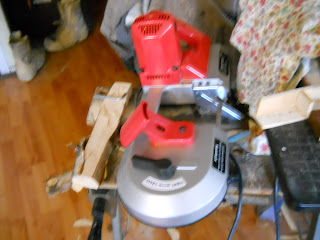 Above, the rear end is being glued up in my homemade clamp. Woodworkers, regardless of scale, will all agree that you can never, never, have enough clamps. The one above is a bit large, but perfect for its purpose. Next we glue and pin on the front end. For pins I use thin wire, #22 I think, and drill the holes with a jeweler's drill.
Above, the rear end is being glued up in my homemade clamp. Woodworkers, regardless of scale, will all agree that you can never, never, have enough clamps. The one above is a bit large, but perfect for its purpose. Next we glue and pin on the front end. For pins I use thin wire, #22 I think, and drill the holes with a jeweler's drill. There are quite a few clamps in operation. The toolmaker's clamp, along with the jeweler's drill and bits to suit, are available from Lee Valley, my favorite tool place.
There are quite a few clamps in operation. The toolmaker's clamp, along with the jeweler's drill and bits to suit, are available from Lee Valley, my favorite tool place.Now comes the wheeling, so we put the wheels on the running gear.
 I have dowel axle pins put in. There are also wire pegs sticking up. These are to match the springs. Amazingly, the buggy is attached to the running gear only by springs. So I had to make the springs. These were made out of an old bandsaw blade, annealed, teeth ground off, formed around a block, and wired together. For this wire, I use the kind of wire that holds lettuce together at the supermarket. Free with my salad. Strip off the paper and there you are. You can just see the springs in the next picture.
I have dowel axle pins put in. There are also wire pegs sticking up. These are to match the springs. Amazingly, the buggy is attached to the running gear only by springs. So I had to make the springs. These were made out of an old bandsaw blade, annealed, teeth ground off, formed around a block, and wired together. For this wire, I use the kind of wire that holds lettuce together at the supermarket. Free with my salad. Strip off the paper and there you are. You can just see the springs in the next picture. The springs, "elliptical" they are called, are being held in place by even smaller toolmaker's clamps. This whole business is all about clamps. I could not deliver the buggy that way! So I made a nut out of a piece of very thick wire, courtesy of Mat-Su Electrical co-op; they left about a foot of cable lying around after wiring up somebody; I pounced on it, cut off a little section, and laboriously drilled a Morse #70 hole through it; then I forced it on to the wire, and it acts as a nut. So then we attach the wheels permanently, with pins (they can turn); we carve out a seat, put on the rear deck, and ta-da (music, please, Houston! Thanks):
The springs, "elliptical" they are called, are being held in place by even smaller toolmaker's clamps. This whole business is all about clamps. I could not deliver the buggy that way! So I made a nut out of a piece of very thick wire, courtesy of Mat-Su Electrical co-op; they left about a foot of cable lying around after wiring up somebody; I pounced on it, cut off a little section, and laboriously drilled a Morse #70 hole through it; then I forced it on to the wire, and it acts as a nut. So then we attach the wheels permanently, with pins (they can turn); we carve out a seat, put on the rear deck, and ta-da (music, please, Houston! Thanks): The Doctor Buggy is complete. Much remains to be done on this tableau. We need a horse, for instance, to draw the buggy. And the harness, and the shafts. We need a doctor to drive the buggy! We need a nurse and at least one patient. But this is a long-tem project. Making models is fun. I still have a lot to learn about wheels, for instance. But for the moment it will do very well. I wanted to put steel tires on the wheels, but had no suitable steel on hand.
The Doctor Buggy is complete. Much remains to be done on this tableau. We need a horse, for instance, to draw the buggy. And the harness, and the shafts. We need a doctor to drive the buggy! We need a nurse and at least one patient. But this is a long-tem project. Making models is fun. I still have a lot to learn about wheels, for instance. But for the moment it will do very well. I wanted to put steel tires on the wheels, but had no suitable steel on hand.




























